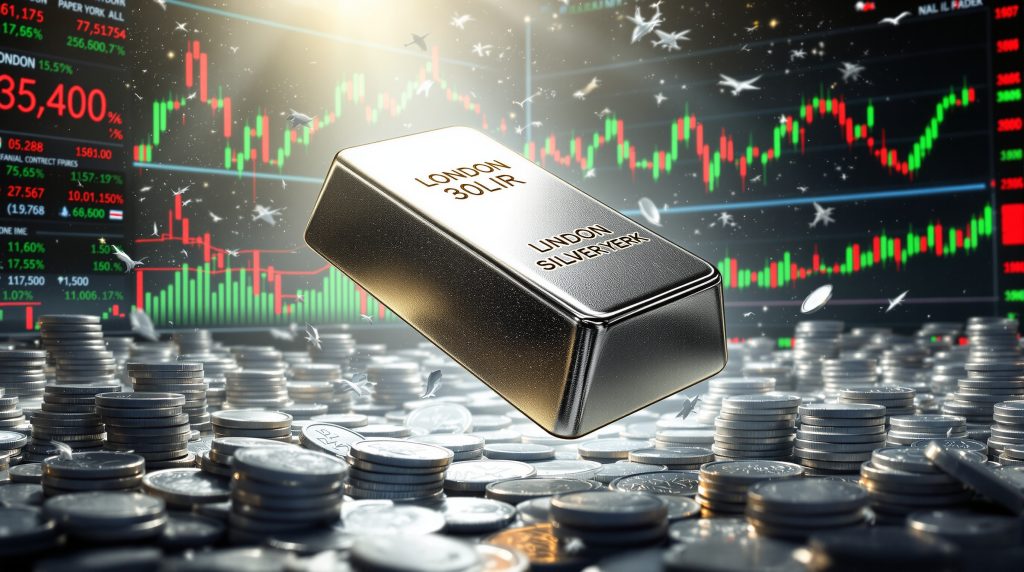Understanding the Silver Short Squeeze: Market Dynamics and Global Impact
A silver short squeeze occurs when investors who bet against silver prices are forced to cover their positions by buying back silver as prices rise, creating a self-reinforcing upward spiral. In 2025, this market phenomenon reached historic levels, driving silver prices to unprecedented heights and disrupting global precious metals markets. Understanding the mechanics, causes, and implications of this silver market squeeze impact provides insight into a rare market event with far-reaching economic consequences.
What Is a Silver Short Squeeze and How Does It Work?
The Mechanics Behind a Short Squeeze
A silver short squeeze represents a market condition where traders who borrowed and sold silver (going "short") are forced to buy it back as prices rise, further accelerating the price increase. This creates a powerful feedback loop where rising prices force more short sellers to exit positions, driving prices even higher. In the silver market, this dynamic is particularly potent because the physical market is relatively small compared to the enormous paper trading volume.
Short sellers typically borrow silver contracts with the intention of buying them back later at lower prices. However, when prices move against these positions, they must purchase silver to close their positions, adding buying pressure to an already rising market. This forced buying can transform an ordinary price increase into a dramatic upward spiral.
Physical vs. Paper Silver Imbalance
A fundamental vulnerability in silver markets stems from the significant imbalance between physical metal availability and paper trading contracts. The paper silver market—consisting of futures contracts, options, and other derivatives—dwarfs the amount of actual physical silver available for delivery.
While precise ratios are difficult to quantify, industry analysts have suggested the number of paper claims on silver far exceeds physical inventories. This structural disconnect creates a potentially explosive situation when even a modest percentage of paper contract holders demand physical delivery simultaneously.
The inherent mismatch between paper promises and physical metal means that during periods of heightened demand, physical silver can command substantial premiums over spot prices quoted on exchanges. During the 2025 squeeze, this disconnection became particularly evident in major trading hubs.
Historical Context of Silver Squeezes
The 2025 silver short squeeze echoes previous market dislocations, most notably the infamous 1980 Hunt brothers' attempt to corner the silver market. In that episode, Nelson Bunker Hunt and William Herbert Hunt accumulated massive silver positions, driving prices from around $6 to nearly $50 per ounce before the market collapsed following regulatory intervention.
The October 2025 squeeze sent silver to $53.55 per ounce, exceeding the 1980 peak by approximately $1. This marked a historic milestone, representing one of the few times silver has surpassed the $50 threshold. While silver briefly approached these levels during a rally in April 2011, touching around $49.82 intraday, the 2025 event solidified itself as an extraordinary market event by sustaining prices above the $50 mark.
Unlike the 1980 episode, which resulted primarily from concentrated buying by the Hunt brothers, the 2025 squeeze emerged from broader market dynamics and multiple contributing factors rather than a deliberate cornering attempt.
What Triggered the 2025 Silver Short Squeeze?
Supply-Demand Mismatch in Physical Markets
The immediate catalyst for the 2025 squeeze was an acute shortage of physical silver in key trading hubs, particularly London. This shortage created a significant disconnect between spot prices (the current market price) and futures contracts, with physical silver commanding substantial premiums.
Physical inventories in London vaults became severely depleted, reducing available metal for immediate delivery and creating a liquidity crisis in the spot market. The shortage was reflected in silver lease rates—the cost of borrowing physical silver—which surged to extraordinary levels.
By mid-October 2025, one-month silver lease rates had reached more than 30% on a Friday, though they moderated to approximately 14% by the following Tuesday. Even more dramatic were overnight lease rates, which spiked above 100% late in the previous week before settling around 30% by October 14, according to information from market participants.
Geographic Arbitrage Opportunities
The supply-demand imbalance wasn't uniform globally, creating significant price disparities between major trading centers. London silver prices developed substantial premiums compared to New York, creating lucrative arbitrage opportunities for traders who could move physical metal between markets.
These regional price differences became so substantial that traders began booking cargo space on transatlantic flights specifically for silver bars—an expensive transport method typically reserved for gold due to its higher value-to-weight ratio. This extraordinary logistical response highlighted the severity of the regional imbalances and the profit potential from exploiting the price gaps.
As metal began flowing to the premium market, the arbitrage opportunity started to erode, though price differences remained at historically elevated levels through mid-October. The willingness of traders to incur the high costs of air transport for silver demonstrated the exceptional nature of the market dislocation.
Regulatory Uncertainty and Tariff Concerns
Market anxiety about potential US tariffs on silver imports added another layer of complexity to the squeeze. Earlier in 2025, concerns about possible tariffs under Section 232 investigations into critical minerals (which included silver, platinum, and palladium) had already created dislocations between London and New York markets.
Although precious metals had been officially exempted from tariffs in April 2025, traders remained concerned about potential policy reversals or new trade restrictions. This regulatory uncertainty discouraged some market participants from releasing physical inventory, contributing to supply tightness.
The Trump administration's Section 232 probe revived fears that silver could be swept up in new tariffs, exacerbating market tightness and encouraging precautionary inventory holding. This political dimension added a unique element to the 2025 squeeze that wasn't present in previous market disruptions.
How Are Global Silver Markets Responding?
London Market Liquidity Crisis
The London silver market, traditionally the global center for physical silver trading, experienced severe liquidity constraints during the squeeze. The shortage of available metal for immediate delivery drove lease rates to extraordinary levels, reflecting the premium placed on physical possession.
Silver lease rates represent the annualized cost of borrowing metal in the London market. The spike to over 30% for one-month leases and over 100% for overnight borrowing reflected an extreme scarcity of lendable metal. These rates were multiples higher than typical leasing costs, which normally range in the low single digits.
The liquidity crisis affected market functionality, widening bid-ask spreads and reducing the depth of markets. Trading volumes in spot markets declined as participants became reluctant to part with physical holdings, further exacerbating price volatility.
Price Divergence Between Trading Hubs
The squeeze created significant price divergence between major trading hubs. London prices traded at substantial premiums to New York, reflecting the regional nature of the physical shortage. This divergence triggered international shipments of silver bars as traders sought to capitalize on the price differential.
By mid-October 2025, the price gap had begun to narrow as arbitrage activities increased the flow of metal to premium markets. However, prices remained at historically elevated levels, with spot silver trading at $51.89 per ounce as of October 14, 2025.
The regional price differences underscored how physical commodity markets can fragment during periods of stress, with local supply-demand dynamics temporarily overwhelming the forces that normally keep global markets aligned.
Central Bank and Institutional Responses
Unlike gold, which benefits from central bank buying during market turbulence, silver lacks significant official sector backing to stabilize markets during extreme volatility. Central banks generally hold minimal silver reserves compared to substantial gold holdings, leaving silver markets more vulnerable to private sector investment flows.
This absence of a "buyer of last resort" makes silver markets more susceptible to dramatic price swings and prolonged squeezes when investment flows shift suddenly. Without central bank stabilization, even temporary changes in investment sentiment can trigger disproportionate price movements.
As Goldman Sachs analysts noted during the squeeze: "Without a central bank bid to anchor silver prices, even a temporary pullback in investment flows could trigger a disproportionate correction, as it would also unwind the London tightness that drove much of the recent rally."
What Factors Are Amplifying the Silver Squeeze?
Indian Demand Surge
A significant increase in silver demand from India contributed substantially to the drawdown of available physical silver. According to multiple market participants, a jump in Indian buying in the weeks preceding the squeeze reduced the supply of available bars trading in London.
India traditionally represents one of the world's largest silver consumers, with demand driven by jewelry, investment, and industrial applications. The timing of increased Indian buying—coinciding with already tight market conditions—created a perfect storm for physical availability.
The Indian demand surge highlighted how regional buying patterns can have global market implications, particularly in relatively small commodity markets like silver. With the global silver market approximately nine times smaller than gold's, according to market analysts, even moderate changes in regional demand patterns can trigger significant price effects.
ETF Investment Flows
Exchange-traded funds (ETFs) backed by physical silver played a crucial role in the 2025 squeeze by removing substantial metal from market circulation. Unlike futures contracts, which represent paper claims, silver ETFs must purchase and vault actual metal to back their shares.
As investment interest in silver increased throughout 2025, inflows into these funds absorbed significant quantities of physical silver. This reduction in available inventory directly impacted market liquidity, as metal held in ETF investment guide vaults becomes unavailable for other market participants unless investors sell their ETF shares.
The ETF mechanism creates a direct link between investment demand and physical market tightness that doesn't exist in many other commodity markets. During the squeeze, this structural feature amplified the price impact of increased investor interest.
Broader Precious Metals Rally
The silver squeeze unfolded within a broader bull market across all precious metals. According to market data, the four main precious metals (gold, silver, platinum, and palladium) had surged between 58% and 82% in 2025 prior to the October squeeze.
Gold reached $4,151.60 per ounce on October 14, 2025, after touching an all-time high of $4,179.70 earlier that day. This broad-based precious metals strength attracted additional investment interest to silver, amplifying the squeeze dynamics.
The sector-wide momentum reflected a combination of macroeconomic factors, including U.S.-China trade tensions, Federal Reserve policy shifts, and concerns about a potential U.S. government shutdown. These conditions created a favorable environment for precious metals generally, with silver's smaller market size making it particularly susceptible to price surges.
How Are Traders and Investors Navigating the Squeeze?
Short Covering Strategies
Traders holding short positions in silver faced difficult decisions as prices rose dramatically. Those who maintained short positions despite rising prices saw mounting losses, while those who covered positions by buying silver contributed to further upward price pressure.
Professional traders typically employ risk management strategies including position limits and stop-loss orders that trigger automatic covering of short positions at predetermined price levels. As these stops triggered across multiple trading entities simultaneously, they created cascading buying pressure that accelerated price increases.
For commercial participants using silver futures to hedge physical positions, the squeeze created less direct exposure, as their paper losses would be offset by gains in their physical holdings. However, the extreme volatility still complicated risk management and created potential cash flow challenges from margin calls.
Physical Delivery Logistics
The premium for physical silver prompted unprecedented logistical arrangements, including air freight shipments of silver bars between continents. These expensive transport solutions highlighted the extraordinary measures traders undertook to capitalize on regional price disparities.
Typically, silver moves between markets via ocean shipping due to its relatively low value-to-weight ratio compared to gold. The use of air freight for silver represented an exceptional response to the extreme market conditions and the substantial profits available from arbitrage activities.
According to market participants, these shipments were expected to arrive "in the coming days and weeks" after mid-October, potentially easing physical tightness in premium markets and helping to normalize price relationships between trading hubs.
Market Participant Positioning
Different market participants experienced varying exposure to the squeeze based on their positioning:
- Commercial hedgers (miners and industrial users) typically maintain offsetting physical positions that provide natural protection against paper market volatility
- Speculative traders without physical backing faced the greatest squeeze pressure, particularly those with short positions
- Long-term investors holding physical silver benefited from price appreciation
- Arbitrage traders who could access physical metal profited from regional price disparities
Market professionals with experience from previous commodity squeezes generally maintained more conservative positions, while newer market participants sometimes found themselves overexposed to squeeze dynamics.
What Are the Economic Implications of the Silver Squeeze?
Industrial Impact Concerns
Silver's dual nature as both precious metal and industrial commodity means price spikes affect manufacturing sectors reliant on silver inputs. Industries particularly exposed include:
- Electronics manufacturing (silver is essential for conductivity)
- Solar panel production (silver paste for electrical contacts)
- Medical equipment (antimicrobial properties)
- Photography (specialized applications)
- Water purification systems
For manufacturers, sustained high prices could potentially drive material substitution where technically feasible, acceleration of recycling efforts, or passing costs to consumers. The industrial impact depends largely on the duration of elevated prices rather than short-term spikes.
While many industrial users maintain buffer inventories to protect against short-term price volatility, prolonged high prices would eventually flow through to production costs and potentially final product pricing.
Investment Portfolio Effects
The dramatic rise in silver prices significantly impacted investment portfolios with precious metals exposure. Silver outperformed most other asset classes in 2025, potentially changing allocation strategies and drawing new investor interest to the sector.
For diversified portfolios, silver's strong performance provided a counterbalance to potential weakness in traditional financial assets during periods of market uncertainty. This diversification benefit reinforced the rationale for maintaining precious metals exposure within balanced portfolios.
The extreme price movements also created significant opportunities for tactical traders and challenges for risk managers attempting to maintain target allocations. The volatility prompted some investors to reassess appropriate position sizing for silver investments given the demonstrated potential for rapid price changes.
Mining Sector Response
Silver producers benefited substantially from higher prices, though many operate with hedging programs that may have limited their ability to capture the full upside. The mining sector's response to price signals typically lags by years due to development timelines, meaning supply constraints could persist despite strong price incentives.
Most silver production comes as a byproduct of mining other metals (particularly lead, zinc, copper, and gold), making supply relatively inelastic to silver prices alone. Pure silver mines represent only a minority of global production, limiting the market's ability to rapidly increase output in response to higher prices.
The price spike improved project economics for development-stage silver projects, potentially accelerating investment decisions for new mines. However, the volatile nature of squeeze-driven prices complicates long-term investment planning, as miners must assess whether elevated price levels will persist long enough to justify major capital commitments.
When Might the Silver Squeeze Resolve?
Signs of Easing Pressure
By mid-October 2025, certain market indicators suggested the most extreme phase of the squeeze might be moderating. Silver lease rates had declined from peak levels, with one-month rates falling from over 30% to approximately 14%, though this remained far above normal market conditions.
The price gap between London and New York had also narrowed, reflecting the impact of arbitrage activities and increased metal flows to premium markets. Spot silver prices had retreated slightly from peak levels, trading at $51.89 per ounce on October 14 after reaching $53.55 earlier in the session.
These early signs of normalization suggested the market might be beginning to find equilibrium, though conditions remained far from typical. The expected arrival of air-freighted silver bars in the coming weeks promised to further ease physical market tightness.
Potential Correction Risks
Market analysts, including those at Goldman Sachs, warned about the potential for a sharp correction in silver prices. Their analysis highlighted silver's vulnerability to sudden sentiment shifts due to its smaller market size and lack of central bank support.
The analysts noted: "Without a central bank bid to anchor silver prices, even a temporary pullback in investment flows could trigger a disproportionate correction, as it would also unwind the London tightness that drove much of the recent rally."
Historical precedent from previous commodity squeezes suggests that price corrections following extreme squeezes can be rapid and substantial. The speed and magnitude of any correction would likely depend on how quickly physical supply tightness resolves and whether broader macroeconomic factors continue to support precious metals generally.
Long-term Market Structure Implications
The 2025 squeeze highlighted structural vulnerabilities in silver market architecture, potentially leading to calls for reforms in how physical and paper markets interact. Issues brought to the forefront included:
- The relationship between derivatives volume and physical market size
- Transparency requirements for physical inventory reporting
- Delivery mechanisms for futures contracts
- Position limits for large market participants
Future regulatory changes could address concerns about the disconnect between physical availability and paper trading volume. Market participants and exchanges might also implement voluntary reforms to improve market functionality and reduce the likelihood of future squeezes.
How Does the Silver Squeeze Compare to Other Market Events?
Parallels to Previous Commodity Squeezes
The silver squeeze shares characteristics with other famous commodity market squeezes, including the Hunt brothers' silver corner in 1980 and more recent squeezes in nickel and palladium markets. Common elements include:
- Physical delivery constraints
- Large price divergences between related contracts
- Extraordinary borrowing costs for physical commodities
- Regulatory concerns and potential intervention
- Eventual price corrections as supply responses materialize
The 2025 squeeze reached price levels slightly exceeding the Hunt brothers episode, though it stemmed from different underlying dynamics. While the 1980 squeeze resulted primarily from concentrated buying by specific investors, the 2025 event emerged from broader market forces and multiple contributing factors.
Differences from Equity Short Squeezes
Unlike equity market short squeezes (such as GameStop in 2021), the silver market features more complex dynamics due to its physical nature and the presence of commercial hedgers with offsetting positions. Key differences include:
- Physical delivery requirements create additional complexity not present in stock markets
- Commercial users provide natural market balance through hedging activities
- Regional fragmentation creates arbitrage opportunities between trading hubs
- Price discovery occurs across multiple venues (spot, futures, ETFs, physical dealers)
These differences make silver squeezes potentially more persistent but sometimes less extreme than pure speculative squeezes in equities or cryptocurrencies. The necessity of physically moving metal between markets creates friction that can extend the duration of market dislocations.
Global Macroeconomic Context
The silver squeeze occurred against a backdrop of significant global economic uncertainty, including:
- US-China trade tensions creating concerns about global growth
- Potential US government shutdown fears affecting market sentiment
- Federal Reserve policy shifts impacting monetary conditions
- General flight to real assets amid inflation concerns
These factors increased demand for safe-haven assets generally, providing additional support for precious metals prices. Gold's advance was "underpinned by central-bank buying, rising holdings in exchange-traded funds, and rate cuts by the US Federal Reserve," according to market commentary, creating a supportive environment for all precious metals.
FAQs About the Silver Short Squeeze
What is causing the 2025 silver short squeeze?
The 2025 silver squeeze resulted from a confluence of factors creating a perfect storm in precious metals markets. The primary drivers included:
- Acute physical silver shortage in key trading hubs, particularly London
- Increased investment demand coinciding with strong industrial consumption
- A surge in buying from India depleting available supplies
- Significant inflows to silver-backed ETFs removing metal from circulation
- Lingering concerns about potential regulatory changes or tariffs
- Broader strength across the precious metals complex
- The relatively small size of the silver market compared to other commodities
This combination of physical market tightness and strong investment flows created extraordinary pressure on short sellers, forcing them to cover positions at increasingly higher prices.
How high could silver prices go during a short squeeze?
While predictions vary widely, historical precedent suggests prices could remain volatile with potential for additional upside beyond current levels. The 2025 squeeze has already established a new all-time high at $53.55 per ounce, surpassing the previous record from 1980.
Market analysts generally avoid making specific price predictions during squeeze conditions due to the unpredictable nature of short-covering dynamics and potential regulatory interventions. The ultimate price ceiling depends largely on how aggressively shorts cover positions and how quickly additional physical supply reaches premium markets.
Historical commodity squeezes suggest prices could potentially exceed rational valuation metrics during peak squeeze conditions before eventually returning to levels better aligned with fundamental supply-demand balances.
How does this squeeze affect silver mining companies?
Mining companies generally benefit from higher silver prices through improved profit margins and increased valuation. However, the impact varies based on:
- Production cost structure
- Hedging programs that may limit upside exposure
- Proportion of revenue derived from silver vs. other metals
- Development pipeline of new projects
Companies with hedged production may not capture the full upside of price spikes, while unhedged producers enjoy maximum benefit from higher market prices. The volatile nature of squeeze-driven price movements complicates long-term investment planning for mining executives.
For development-stage projects, sustained high prices improve economics and may accelerate investment decisions, though companies typically apply conservative long-term price assumptions rather than spot prices for major capital allocation decisions.
What should investors know about silver market liquidity during a squeeze?
During a squeeze, market liquidity deteriorates significantly across multiple dimensions:
- Bid-ask spreads widen substantially, increasing transaction costs
- Market depth decreases, meaning large orders move prices more dramatically
- Physical silver typically commands significant premiums over spot prices
- Specific products (coins, small bars) may become difficult to source
- Lease rates for borrowing physical metal increase dramatically
- Futures contracts may price differently from spot markets
These liquidity challenges affect different market participants in various ways. Retail investors typically face wider spreads and product availability issues, while institutional participants may struggle with position sizing and execution of larger orders without causing adverse price movements.
Further Exploration:
Readers interested in learning more about silver market dynamics can explore additional educational content through financial market resources, commodity research publications, and industry analysis. Understanding the interplay between physical and paper markets provides valuable context for interpreting price movements in precious metals generally and silver specifically.
The 2025 silver squeeze represents a case study in market structure vulnerabilities, physical commodity logistics, and the potential for disconnects between derivative markets and underlying physical commodities. These dynamics apply to varying degrees across other commodity markets, making the silver squeeze strategies relevant for broader understanding of commodity market functioning.
For investors interested in precious metals allocation strategies, understanding the relationship between gold and silver is crucial. The gold-silver ratio analysis provides important insights for portfolio construction during periods of market volatility like the 2025 squeeze.
Want to Spot the Next ASX Mineral Discovery Before the Market?
Gain an immediate edge on the ASX with Discovery Alert's proprietary Discovery IQ model, which instantly identifies significant mineral discoveries the moment they're announced. Understand why major discoveries can lead to substantial returns by exploring our dedicated discoveries page and begin your 30-day free trial to position yourself ahead of the market.




